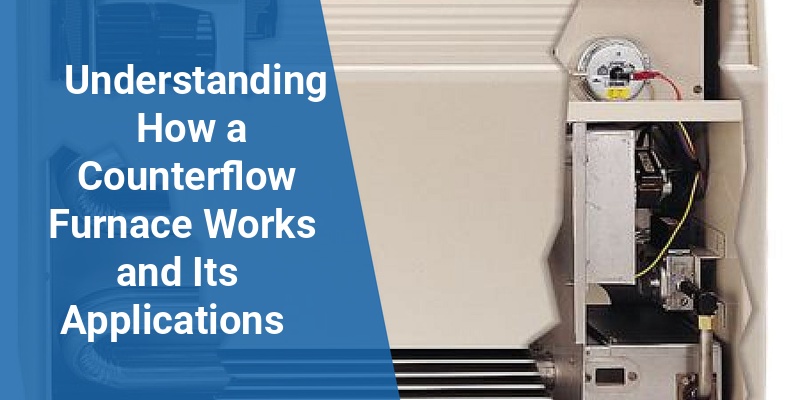A counterflow furnace is a specialized industrial heating system designed to maximize heat transfer efficiency by directing hot gases and materials in opposite directions. This setup allows superior temperature control, energy savings, and improved product quality across various manufacturing processes.
| Feature | Description |
|---|---|
| Design Principle | Hot gases flow opposite to the material’s movement |
| Primary Benefit | Maximized heat transfer efficiency |
| Common Uses | Metal processing, ceramics, chemical treatments |
| Key Advantage | Energy savings and precise temperature control |
What Defines a Counterflow Furnace?
A counterflow furnace employs a heating configuration where the heated gases and materials move in opposite directions, creating a countercurrent flow pattern. This design contrasts with parallel flow systems, which move gases and materials simultaneously in the same direction.
The counterflow principle enhances thermal efficiency by maintaining a high temperature gradient throughout the furnace length. This allows the incoming material to be preheated by the outgoing hot gases, reducing fuel consumption and achieving uniform heating.
Core Components and Operation
A typical counterflow furnace consists of a heating chamber, burner or heat source, gas inlet and outlet, and material feed and discharge points arranged to enable opposite flow paths.
- Heating Chamber: Insulated to retain and evenly distribute heat.
- Burner/Heat Source: Could utilize natural gas, electricity, or other fuels.
- Gas Flow System: Designed to ensure hot gases travel counter to the material flow.
- Material Feed: Positioned to enable preheating by the outgoing gases.
Material enters through one end at a lower temperature and absorbs heat as it travels against the flow of hot gases, which gradually cool before exiting the opposite end.
Advantages of Counterflow Furnaces
Counterflow furnaces offer several key benefits over traditional furnace designs:
- Higher Thermal Efficiency: The countercurrent movement maximizes heat recovery, lowering fuel use.
- Improved Temperature Control: Uniform temperature distribution reduces hotspots and thermal stress.
- Energy Savings: Reduced waste gas temperatures enable reclaiming heat for reuse.
- Enhanced Product Quality: Consistent heating improves material properties and reduces defects.
- Environmental Impact: Lower fuel consumption results in reduced emissions.
Applications Across Industries
The counterflow furnace design is widely utilized across many industrial sectors:
Call 888-906-9139 for Free Local HVAC Quotes – No Obligation, Just Savings!
- Metallurgical Processes: Heat treating metals to enhance hardness and durability.
- Ceramics Manufacturing: Firing ceramics with consistent temperature profiles.
- Chemical Processing: Controlled reactions requiring precise thermal conditions.
- Glass Production: Slowly heating raw glass to prevent thermal shock.
- Food Processing: Drying and roasting techniques benefiting from efficient heat transfer.
Comparison With Parallel Flow Furnaces
| Feature | Counterflow Furnace | Parallel Flow Furnace |
|---|---|---|
| Flow Direction | Opposite flows of gas and material | Same direction flows |
| Thermal Efficiency | Higher, due to heat recovery | Lower, more heat loss |
| Temperature Control | Better uniformity along furnace length | Less uniform temperature |
| Energy Consumption | Lower fuel use | Higher fuel use |
Maintenance and Operational Considerations
Maintaining a counterflow furnace involves ensuring the heating elements and gas flow pathways are clean and functioning optimally. Operators must monitor for:
- Deposits on heating surfaces that can reduce heat transfer efficiency.
- Proper burner operation for consistent heat generation.
- Temperature sensors and controls to maintain setpoints and prevent overheating.
- Gas flow rates that keep the counterflow dynamic balanced.
Routine inspections and timely repairs are vital to sustaining efficiency gains associated with the furnace design.
Energy Efficiency Strategies in Counterflow Furnaces
To maximize the energy-saving potential of counterflow furnaces, operators often implement additional strategies:
- Waste Heat Recovery Systems: Capturing exhaust heat to preheat combustion air or incoming materials.
- Insulation Upgrades: Minimizing heat loss through furnace body and ductwork.
- Advanced Controls: Automated systems optimizing fuel input and airflow in real time.
- Optimized Load Management: Ensuring material throughput matches furnace heating capacity.
Innovations and Future Trends
Modern counterflow furnace designs integrate technology advancements such as:
- Smart Sensors: IoT-enabled devices providing real-time performance data.
- Automation and AI: Systems that predict and adjust parameters for improved efficiency and product consistency.
- Alternative Fuels: Using hydrogen or biofuels to reduce carbon footprint.
- Customizable Modular Designs: Enhancing adaptability to specific industrial needs.
Summary of Key Points
| Attribute | Benefit | Impact |
|---|---|---|
| Counterflow Design | Maximizes thermal exchange | Lower fuel usage, better heating uniformity |
| Energy Efficiency | Enhances heat recovery | Reduces operational costs |
| Industrial Application | Versatile across materials & processes | Widely adopted in manufacturing sectors |
| Maintenance | Requires regular inspection | Ensures sustained performance |
| Future Trends | Incorporates smart technology | Increases automation and sustainability |
